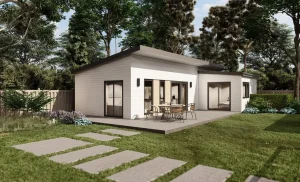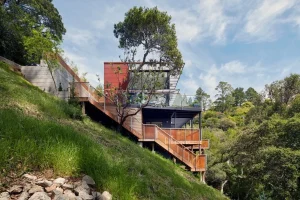Why Would You Build on a Slope?
Some of the most sought residences worldwide are not situated on slopes by mistake. This is why:
· The opinions. In certain circumstances, you can take in breathtaking views of lush valleys or forested woods below, clear sky views above, and unbroken lines of sight for kilometers.
· Landscape design. The chance for stunning landscaping with owning a home on an incline is one of the keys draws for many people.
· The area. Lots with steep slopes enable the addition of a walkout basement that functions as an additional story.
· Natural illumination Don’t forget the bay windows when creating your house layout! Homes perched on a hillside are frequently well positioned to use abundant natural light, a cherished characteristic with heaps of health advantages, including improved mood, better sleep, and increased productivity.
· The solitude. Building on a slope enables you to choose a spot that is off the beaten road for individuals who value seclusion.
How Can a Sloped Lot Be Built On?
The “cut and fill” approach or the use of stilts are the two ways to construct a home on a sloped lot.
The term “cut and fill” describes leveling the foundation’s ground by either removing soil, adding more soil or doing both. To “fill” the plot and level it out, soil can be hauled in. Alternatively, it can be dug (“cut”) from the slope and either trucked away or used to provide retaining walls for the house. Cutting and filling can result in building costs that are many times higher than those for a residence on a level site, depending on the gradient, the soil, and other elements.
Instead of digging into the slope, which requires lifting the house onto wooden or steel columns, employing stilts is an option. In addition to being far more affordable than cut and fill, this approach can expand the range of possible home placement options, such as constructing out over trees or water.
The two main stumbling blocks are the slope’s gradient and the lot’s uphill or downhill orientation.
The gradient grade of a given site will give you a general idea of how difficult it will be to construct. The easiest terrain to build on has an incline of less than 10%, while 11–20% is regarded as moderate. Anything more than 20% is considered steep. Costs start to rise dramatically beyond roughly 15% as the hazards and difficulty of the work both increase.
It is also more difficult to build on an upslope plot than a downslope plot since the area that will be the front of the home rises to the back. These plots typically require cutting or blasting, as well as the transportation and disposal of soil and rocks.
Time and expense for further foundation work
Although it is relatively uncommon for homes to be built on slopes of up to 50%, the cost of the intricate foundation systems necessary for such homes is frequently higher than the price of a complete home on flat ground.
However, even sites with a modest slope may need more concrete, deeper excavation performed with specialist equipment or blasting, retaining walls or terraces, and unique drainage and septic system designs. Higher expenses and lengthier construction schedules result from all the additional labor and supplies required to ensure the house complies with building codes and is safe to occupy.
Water, Sewage, and Drainage
Building on a slope requires careful consideration of surface and underground water drainage. If you’ve ever seen footage of the consequences of mudslides, you’ll understand why.
It is necessary to reroute rainfall runoff away from your property’s foundation without harming nearby homes with water flows and inundating public highways. To stop water from collecting there, retaining walls need to be “tanked” (waterproofed) and drained. Most of the time, swales and culverts can be used to direct runoff to storm water drains or soak away (holes dug in the ground and filled with rubble that allows surface water to percolate back into the ground).
Subsurface water pouring in can be a problem if your property has a full basement below the normal high water table.
Finally, sewage treatment can be challenging depending on how close your residence is to the sewer line. To slow the flow to a suitable rate, you might need to install tumble bays if the line is downhill or a pump if it is uphill.
Staging Areas & Fill Soil Storage
If your plot needs to be cut, the additional soil that results will need to be either taken away or kept in a nearby storage area if it is to be used for filling. You’ll need a staging place for vehicles, equipment, and deliveries, even if you’re not cutting. We strongly advise seeking quotes because if you’re just filling, you’ll need to have dirt trucked into the site, which is an expensive fee that varies greatly depending on geography.
The Construction Site's Resupply
Any natural flora on your new home site could suffer damage over the weeks or months it takes to build your home due to vehicles coming and leaving, heavy equipment being parked, and building materials being strewn about. Before the property takes on the appearance you envisioned when you first started the new home-building process, you may need to wait several months while replanting with cultivated plants or waiting for the natural flora to grow back.



